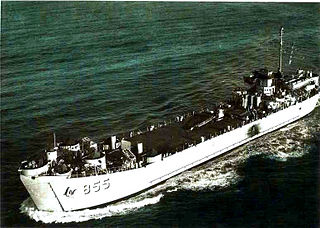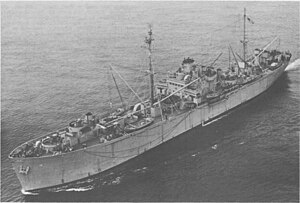
USS Baltimore (CA-68) was the lead ship of her class of heavy cruiser, the fifth ship of the United States Navy named after the city of Baltimore, Maryland.

USS Blue (DD-744), an Allen M. Sumner-class destroyer, was the second United States Navy ship of that name, for Lieutenant Commander John S. Blue (1902–1942).

USS Alfred A. Cunningham (DD-752), an Allen M. Sumner-class destroyer, is the only ship of the United States Navy to be named for Alfred Austell Cunningham, a USMC officer and aviator.

USS Algol (AKA-54) was an Andromeda-class attack cargo ship. She was the first ship of the United States Navy by this name, after Algol, a fixed star in the constellation Perseus. Algol served as a commissioned ship for 22 years and 1 month.

USS Graffias (AF-29), a Hyades-class stores ship, is the only ship of the United States Navy to have this name. The name Graffias is another name for the star Beta Scorpii in the constellation Scorpius.

USS Surfbird (AM-383) was an Auk-class minesweeper built during World War II for the United States Navy. She was the only U.S. Navy ship named for the surfbird.

USS Wiltsie (DD-716) was a Gearing-class destroyer in the United States Navy. She was named for Irving Wiltsie. The destroyer entered service in 1946 and remained active with the United States Navy until 1977, when Wiltsie was decommissioned and sold to Pakistan in 1977. The vessel entered service with the Pakistan Navy as PNS Tariq (D165) in 1978. In 1990, the ship was renamed PNS Nazim to allow the name Tariq to be given to a newly-acquired Type 21 frigate. The ship was then transferred to the Pakistan Maritime Security Agency and used as an alongside "at sea" headquarters for the agency. Though afloat, the vessel no longer sails.

USS Prometheus (AR-3) was a repair ship that served the United States Navy during World War I and World War II. Named after Greek mythology figure Prometheus, she was originally laid down as a collier on 18 October 1907 at the Mare Island Navy Yard, Vallejo, California; launched on 5 December 1908; and commissioned 15 January 1910 as USS Ontario.

USS Luzon (ARG-2) was an internal combustion engine repair ship in service with the United States Navy from 1943 to 1947 and from 1950 to 1960. She was the lead ship in a class of twelve ships and was scrapped in 1974.

USS Toucan (AM-387) was an Auk-class minesweeper acquired by the United States Navy for the dangerous task of removing mines from minefields laid in the water to prevent ships from passing. She was the only U.S. Navy ship named for the toucan, a brightly colored and easily tamed bird of the American tropics, characterized by its large but thin beak.

USS Wabash (AOG-4) was a Patapsco-class gasoline tanker acquired by the U.S. Navy for the dangerous task of transporting gasoline to warships in the fleet, and to remote Navy stations.

USS Jason (AR-8) was the fourth of the Vulcan class repair ship of the United States Navy in service from 1944 to 1995, serving in World War II, Korea, Vietnam, and the Gulf War. At the time of her decommissioning, Jason was the oldest ship in continual commission in the United States Navy, and the final ship in continual commission from World War II onward.

USS Delta (AK-29/AR-9) was the lead ship of her class of repair ships in the United States Navy during World War II. She was originally built as the merchant ship SS Hawaiian Packer before her requisition by the U.S. Navy in 1941. Before conversion to a repair ships, Delta briefly served as a U.S. Navy cargo ship.

USS Kent County (LST-855) was an LST-542-class tank landing ship built for the United States Navy during World War II. Named after counties in Delaware, Maryland, Michigan, Rhode Island, and Texas, she was the only U.S. Naval vessel to bear the name.

USS Laertes (AR-20) was a Xanthus class repair ship in the service of the United States Navy from 1945 to 1972.

USS Navasota (AO-106) was an Ashtabula-class replenishment oiler that served in the U.S. Navy from 1946 to 1973, then transferred to the Military Sealift Command to continue service as United States Naval Ship USNS Navasota (T-AO-106) until taken out of service in 1992. Navasota was sold for scrapping in 1995. She was the only U.S. Navy ship to bear the name Navasota.

USS Sussex (AK-213) was an Alamosa-class cargo ship that was constructed for the US Navy during the closing period of World War II. She was retained by the Navy for post-war service, including that in the Korean War theatre where she earned three battle stars and then returned home for deactivation.

USS Gardiners Bay (AVP-39) was a United States Navy seaplane tender in commission from 1945 to 1958 that saw service in the latter stages of World War II and in the Korean War. After her decommissioning, she was transferred to Norway, and she served in the Royal Norwegian Navy as the training ship HNoMS Haakon VII (A537) from 1958 to 1974.

USS Tutuila (ARG-4) was a Luzon-class internal combustion engine repair ship that saw service in the United States Navy during World War II, The Korean War, and The Vietnam War as well as several smaller actions. Named for the Island of Tutuila, the largest and main island of American Samoa, it was the second US Naval vessel to bear the name. After serving for nearly 30 years Tutuila was sold to the Republic of China in 1972.

USS Hooper Island (ARG-17) was a Luzon-class repair ship designated for internal combustion engine repair in service with the United States Navy from 1945 to 1948 and from 1952 to 1959. She was sold for scrapping in 1960.




















